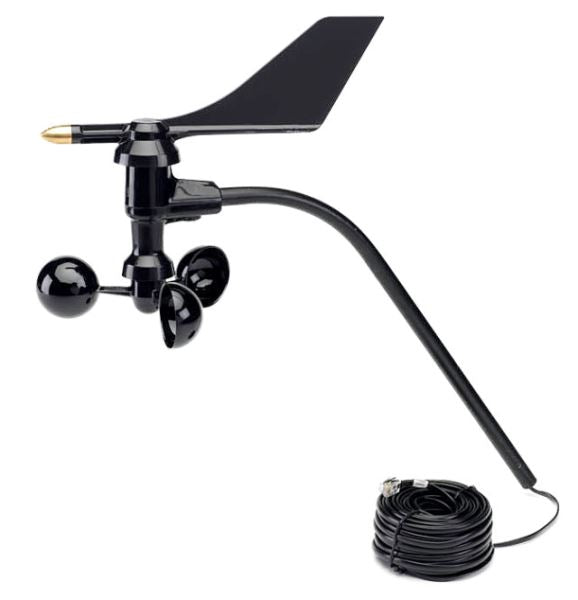Why an Anemometer is Crucial for Your Environmental Information Collection
Why an Anemometer is Crucial for Your Environmental Information Collection
Blog Article
Checking Out the Features and Advantages of Anemometers for Weather Condition Fanatics and Experts
Anemometers stand as instrumental devices in the realm of weather surveillance, catering to both fanatics and experienced specialists alike. These gadgets use a window right into the vibrant globe of wind patterns and rates, giving important data for atmospheric evaluation and projecting. From cup anemometers to sonic anemometers, each type brings its distinct set of benefits and applications, clarifying different aspects of weather. As we look into the features and advantages of anemometers, a deeper understanding emerges not just of prevailing weather phenomena however likewise of the broader implications for fields like wind power manufacturing and ecological research study.
Relevance of Anemometers in Climate Tracking
Anemometers play an essential role in weather condition monitoring by giving precise measurements of wind rate, assisting in projecting and understanding weather condition patterns. These tools, ranging from standard cup anemometers to contemporary ultrasonic anemometers, are necessary for meteorologists, researchers, and weather condition enthusiasts alike. By determining wind rate, anemometers aid in determining the strength of weather phenomena such as typhoons, tornados, and tornadoes. Furthermore, they offer useful data for aviation, maritime operations, and different sectors that are sensitive to wind conditions.

Kinds of Anemometers and Their Applications
The most common types of anemometers consist of mug anemometers, vane anemometers, hot-wire anemometers, and ultrasonic anemometers. Mug anemometers are composed of 3 or four mugs mounted on horizontal arms that rotate with the wind, determining its rate. Vane anemometers, on the various other hand, utilize a freely rotating vane to straighten with the wind direction, supplying both wind rate and instructions dimensions.
Each kind of anemometer has its distinct advantages and applications. Cup anemometers are durable and ideal for general weather surveillance, while vane anemometers are favored for directional dimensions. Hot-wire anemometers are delicate to low air speeds, making them excellent for interior atmospheres. Ultrasonic anemometers are non-intrusive and provide high accuracy, commonly utilized in study and specialized weather condition monitoring applications. Comprehending the qualities and applications of each type of anemometer is important for choosing one of the most ideal instrument for certain weather condition keeping track of needs.
Advantages of Utilizing Anemometers in Projecting
In weather forecasting, the application of anemometers offers very useful benefits for enhancing the precision of climate forecasting. Anemometers gauge wind speed and instructions, offering vital information for predicting weather patterns. By incorporating wind data into forecasting versions, meteorologists can much better recognize the movement of weather systems, prepare for adjustments in weather, and problem extra exact projections.
Furthermore, anemometers play a vital function in evaluating possible weather hazards. Keeping track of wind rates helps forecasters forecast severe weather occasions such as hurricanes, tornadoes, and wintertime tornados with better precision. This early warning system allows authorities to provide prompt informs and carry out essential safety and security procedures, reducing the dangers to life and building.
Additionally, anemometers assist in enhancing renewable resource manufacturing. By assessing wind patterns, meteorologists can identify appropriate areas for wind ranches and forecast power output, adding to the effective generation of wind power.

Anemometers in Wind Power Production
Given the important role anemometers play in giving exact wind information for weather condition projecting and hazard evaluation, their value reaches the world of wind energy manufacturing. Anemometers are essential tools in the field of wind energy, where the measurement of wind speed and direction is essential for establishing the usefulness and efficiency of wind turbine installations. By precisely determining wind rates at varying heights, anemometers assist enhance the positioning and design of wind generators to maximize energy outcome.
In wind farms, anemometers are strategically positioned to collect real-time wind data that is utilized to examine the potential power manufacturing of a site. This information contributes in identifying the economic stability of wind energy projects and in projecting energy generation to make certain grid security. Furthermore, anemometers help in keeping track of wind problems to enhance turbine performance, stop damages from high winds, and guarantee the safety and security of personnel operating in the vicinity of wind turbines.
Enhancing Weather Condition Recognizing With Anemometers

Anemometers play a crucial duty in improving our understanding of microclimates. These local climate condition can differ significantly from broader local projections, making it vital to have accurate data for details areas. anemometer. By strategically positioning anemometers in various locations, researchers can gather detailed info on exactly how wind behaves in different terrains, urban environments, or bodies of water
Moreover, anemometers site web add to improving weather condition projecting designs by giving real-time information on wind habits. This info is particularly important for forecasting extreme weather condition events, optimizing agricultural techniques, and sustaining markets like air travel and maritime navigation. In general, anemometers are important tools that enable us to dig deeper right into the complexities of weather condition systems, ultimately bring about more accurate predictions and better-informed choices.
Final Thought
In final thought, anemometers play an essential function in climate monitoring and projecting by gauging wind rate and direction. Anemometers likewise have applications in wind energy production, additional highlighting their relevance in both weather forecasting and renewable energy markets.
From cup anemometers to sonic anemometers, each type brings its unique set of advantages and applications, dropping light on numerous elements of climatic problems. These tools, ranging from standard mug anemometers to contemporary ultrasonic anemometers, are necessary for meteorologists, researchers, and weather condition lovers alike. The most common kinds of anemometers consist of mug anemometers, vane anemometers, hot-wire anemometers, and ultrasonic anemometers. Mug anemometers are appropriate and durable for general weather monitoring, while vane anemometers are preferred for go to this site directional dimensions. Anemometers are essential instruments in the field of wind power, where the dimension of wind rate and instructions is crucial for identifying the usefulness and performance of wind turbine installments.
Report this page